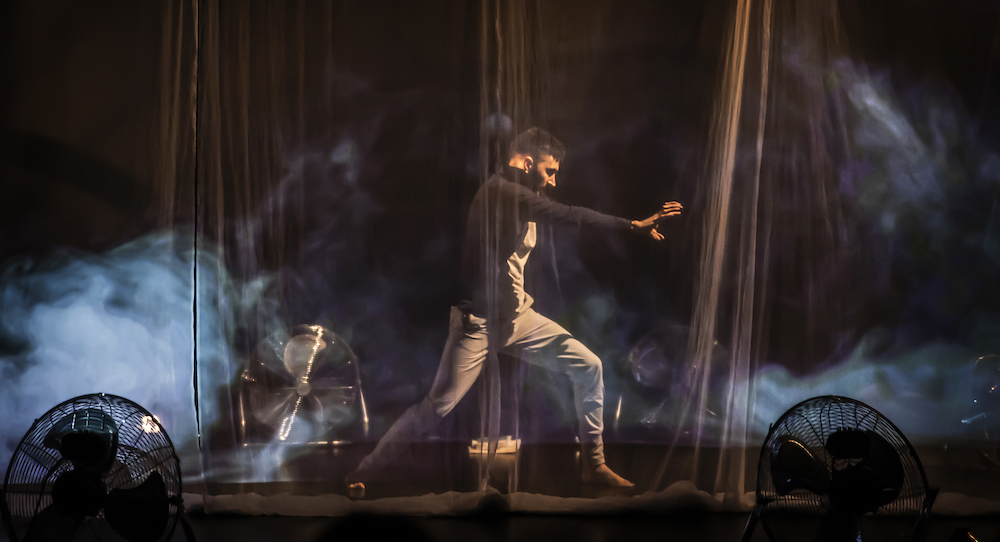First, imagine misspelling your own name. Not once or twice but throughout childhood and adolescence.
Now, rather than rack your brain for the right way to label it, sit with the idea. Picture it as your experience of growing up. What are you feeling? What are you thinking about yourself? How are you making sense of this?
For UK based dancemaker Aakash Odedra, this reality was more than a word – dyslexia – it was a world. As he tells it, “I always spelled my name Akash, and even though I flicked through my passport a million times, I never noticed the other A. It was only at 21 that I noticed. It was strange that it took me 21 years to correct this mistake. It was also strange that I spelled the most basic, fundamental part of my own identity incorrectly for all those years.”

From the outside, knowing now that Odedra is an internationally lauded dancer/choreographer, this may seem inconceivable. “But what was even more odd,” he recalls, “was when I finally found that missing A, I felt like I found a sense of control.”
Moving forward nearly two decades, and that newfound agency has been distilled into the much-loved Little Murmur, a collaboration with choreographer Lewis Major that has garnered critic love, toured extensively, and made an impact with audiences young and old. Soon, it will make its debut in Major’s home state of South Australia.
“The feedback has been extremely moving,” Odedra says of the work. Since it premiered at the Spark Festival in Leicester, England, in 2022, Little Murmur has played theatres, libraries and schools across the UK and Europe. “It’s had many people in tears, not only those with dyslexia but people who have just struggled to find their identity and celebrate their individuality,” Odedra notes.
Yet, in spite of the fine words, Odedra and Major (alongside musician Nitin Sawhney and the visual effects team at Ars Electronica FutureLab) have been faced with the creative challenge of representing the dyslexic experience in the figurative language of dance. No mean feat.
“There are many challenges choreographing and directing because I can visualise the grand image before I’ve begun the process,” Odedra explains. “I can feel it, but it becomes hard to articulate to your collaborators because people, in general, want logic or rationality, which I don’t have, nor do I work with. I work with pure instinct, and for me, it’s about pushing the emotional narrative more than the dramaturgy.”

With Little Murmur, that emotion was clearly more immediate. It is not a dry, conceptual work, and its roots in personal experience would likely have amplified its creator’s desire to remain true to the feeling. As Odedra acknowledges, “It becomes a challenge when you’re trying to bring people into this world of chaos, which to them seems upside down and senseless. I don’t like conflict and often find myself trying to make the vision fit collaborators’ thoughts. It took me a long time to fully trust my dyslexic intuition.”
As he and Major prepare to remount the work in Melbourne, Darwin and Adelaide this winter, another hurdle looms. Given its staging and technical elements – confetti, projections, etc – and the fact that it will play to both school and adult audiences during its Australian run, Little Murmur is a necessarily fluid production.
However, Odedra is quick to point out that this flexibility runs deeper than pragmatic theatrical norms. ”Sometimes, the dancers who perform it do showings to children, who really react instinctively. That can’t be ignored by the performer. You have to acknowledge and incorporate that into the performance. We’re dealing with people’s emotions, and we have to be very organic and responsible with that.”
In saying this, he is referencing his own experience. “When I would look at letters on a board, or at objects, they would often warp and shift shape and form,” he elaborates. “It was as real as the person sitting next to me in my classroom. Letters dashed around on the blackboard and formed flocks, like starlings.”
Since then, Odedra has not only discovered the second A in his name but forged a reputation as a dynamic dancemaker, bringing traditional South Asian forms and Western contemporary practise together to create an award-winning body of work, and to spearhead the world renowned company that now bears his name.

“Dyslexia transformed from a curse to a blessing the moment I embraced it and stopped trying to become normal,” he adds. “It’s part of my creative personality and being. It brings chaos and peace at the same time. It is both the instigator and solution in my life. When I am lost for words, I dance.”
For an artist whose CV includes the solo Rising and the beautiful duo Samsara, it may well be that Little Murmur is his most communal work. “Though about dyslexia, it goes beyond that,” he says. “It’s ultimately about celebrating your own difference, but also celebrating the same in others. We’ve all struggled at some point in our lives. It’s about perspectives and helping one understand the other. So far, people have been moved by the show, and that’s why I suppose it’s still touring.”
In this way, the little murmur gets louder – becoming a fully-fledged voice that speaks to something in all of us.
Aakash Odedra Company and Lewis Major Projects will present Little Murmur at Adelaide Festival Centre’s Space Theatre from 21 – 24 August. For tickets and more information, visit www.adelaidefestivalcentre.com.au/whats-on/little-murmur.
Full dates for the National Tour of Little Murmur are: 25 July – 4 August (Arts Centre Melbourne), 9 – 10 August (Sydney Opera House), 17 – 19 August (Darwin Entertainment Centre), and 21 – 24 August (Adelaide Festival Centre).
By Paul Ransom of Dance Informa.















